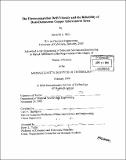| dc.contributor.advisor | Carl V. Thompson. | en_US |
| dc.contributor.author | Wei, Frank L. (Frank Lili), 1977- | en_US |
| dc.contributor.other | Massachusetts Institute of Technology. Dept. of Materials Science and Engineering. | en_US |
| dc.date.accessioned | 2006-03-24T18:21:47Z | |
| dc.date.available | 2006-03-24T18:21:47Z | |
| dc.date.copyright | 2004 | en_US |
| dc.date.issued | 2004 | en_US |
| dc.identifier.uri | http://hdl.handle.net/1721.1/30124 | |
| dc.description | Thesis (S.M.)--Massachusetts Institute of Technology, Dept. of Materials Science and Engineering, 2004. | en_US |
| dc.description | Includes bibliographical references (p. 96-98). | en_US |
| dc.description.abstract | Cu has replaced Al as the interconnect metal of choice for high performance Si-based integrated circuits. Its electromigration behavior must be quantified and an experimental basis for a circuit-level reliability assessment is needed. Experiments on straight two-terminal via-to-via Cu dual-damascene segments with different line lengths, both with via-above and via-below geometries, have been carried out. By contrasting the failure characteristics of via-above and via-below structures, the Cu/Si3N4 interface has been identified as the site for void nucleation and the most dominant diffusion path. Consequently, an asymmetry in lifetime exists between via-above and via-below interconnect lines. It has also been found that at short line lengths, true Blech immortality occurs only for very short lines, at best, due to the ease of void nucleation. Immortality due to void growth saturation is also limited, because, in the absence of the conducting refractory-metal current-shunting overlayers characteristic of Al technology, very small voids at vias can cause failures. We find that at long lengths a sub-population of Cu lines is immortal. We propose that this is a result of non-blocking liners at the base of the vias associated with the high stresses developed at the ends of the lines. In order to quantify the fundamental Cu electromigration kinetics which precedes all failure modes, electromigration drift velocity measurements were carried out using fully processed interconnect structures. It was observed that in a significant fraction of the test population, the resistance of the lines increased steadily over time prior to failure. | en_US |
| dc.description.abstract | (cont.) It is postulated that this gradual resistance increase results from void growth and that the rate of resistance increase correlates with the drift velocity for electromigration. Through drift measurements, we determined the activation energy for electromigration is 0.80±0.06eV. The values of the drift velocities determined in vias-below lines were similar to those measured in vias-above lines. This fact supports the proposal that the asymmetry in reliability between the two different configurations is associated with the void sizes required for failure. Reliability characterization of dotted-I and T-shaped Cu interconnect trees was also carried out. Similar to Al, we found that individual interconnect segments cannot serve as fundamental reliability units (FRU). Unlike Al, we found that Cu interconnect trees are not the FRUs either, due to possible non-blocking vias. Furthermore, due to low stress required for void nucleation in Cu- compared to Al-based interconnects, Cu reliability behavior points to the need to develop a via-based reliability assessment methodology. An atomic reservoir effect for Cu was not indicated by the investigation T-shaped trees. This leads to conservative void growth model for circuit-level reliability assessment methodology. | en_US |
| dc.description.statementofresponsibility | by Frank L. Wei. | en_US |
| dc.format.extent | 98 p. | en_US |
| dc.format.extent | 3325265 bytes | |
| dc.format.extent | 3325072 bytes | |
| dc.format.mimetype | application/pdf | |
| dc.format.mimetype | application/pdf | |
| dc.language.iso | eng | en_US |
| dc.publisher | Massachusetts Institute of Technology | en_US |
| dc.rights | M.I.T. theses are protected by copyright. They may be viewed from this source for any purpose, but reproduction or distribution in any format is prohibited without written permission. See provided URL for inquiries about permission. | en_US |
| dc.rights.uri | http://dspace.mit.edu/handle/1721.1/7582 | |
| dc.subject | Materials Science and Engineering. | en_US |
| dc.title | The electromigration drift velocity and the reliability of dual-damascene copper interconnect trees | en_US |
| dc.type | Thesis | en_US |
| dc.description.degree | S.M. | en_US |
| dc.contributor.department | Massachusetts Institute of Technology. Department of Materials Science and Engineering | |
| dc.identifier.oclc | 55872061 | en_US |
